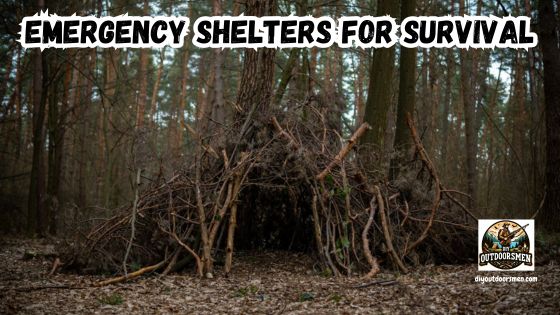Contents
- 1 Essential Considerations for Building Emergency Shelters
- 2 Basic Shelter Types for Wilderness Survival
- 3 Quick Guide to Building Emergency Shelters
- 4 Challenges and Considerations When Building Emergency Shelters
- 5 Advanced Techniques and Tips for Shelter Building
- 6 Essential Tools and Materials for Building Emergency Shelters
- 7 Additional Considerations and Innovations in Emergency Shelter Building
- 8 Frequently Asked Questions on Emergency Shelters
- 8.1 How do I choose the best location for an emergency shelter?
- 8.2 What if I don’t have many natural materials available?
- 8.3 How do I keep my emergency shelters warm in particularly cold conditions?
- 8.4 How long does it take to build an emergency shelter?
- 8.5 Can emergency shelters be modified for longer-term use?
- 9 Final Thoughts on Emergency Shelters
Building emergency shelters for survival is a practical skill that can help you stay safe during unexpected situations. I have spent time studying various techniques and experimenting in different conditions to learn what works best.
In this article I provide an overview of shelter types, practical steps, challenges, and advanced methods to create effective shelters when nature or other emergencies force you to rely on your own resourcefulness.
QUICK LOOK: Tips for Emergency Survival Shelters
- Choose Your Location: Identify a dry area that is protected from strong winds. Look for natural features such as fallen trees or rock outcroppings that can provide structural support.
- Clear the Area: Make sure the ground is free of hazards. Remove debris that might hinder a smooth sleeping area or cause discomfort.
- Gather Materials: Use available natural elements like branches, leaves, and rocks. If you carry extra materials such as a tarp or emergency blanket, keep them accessible.
- Establish a Framework: For structures like a debris hut or lean-to shelter, start with a frame built from sturdy branches. Make sure the frame creates a stable base to support additional layers.
- Insulate the Shelter: Pile on layers of natural materials to create insulation. This step is essential in keeping the interior warm during cold nights.
- Secure the Shelter: Check that your construction is stable. If you have extra rope or cord, use it to secure any loose sections that might collapse under heavy winds or rain.
- Test and Adjust: Once your shelter is complete, test it by seeking cover and making adjustments if needed. Small tweaks can give a boost to insulation or wind protection.
Essential Considerations for Building Emergency Shelters
When you find yourself in a survival situation, having a reliable shelter is one of the most very important needs. It offers protection from weather, predators, and the cold. I have seen that paying attention to key factors such as location, insulation, and available materials can help make a shelter effective and safe.
While there are several ways to construct emergency shelters, I have found that the basics remain the same. You need to consider environmental conditions, available natural materials, and time. Understanding these points will help you choose the most suitable shelter for your situation.
Basic Shelter Types for Wilderness Survival
There are several types of emergency shelters that can be built using natural materials or simple tools. In my experience, focusing on shelter types that are versatile and require minimal resources is effective in a survival scenario. Among the most reliable are the debris hut, lean-to, tarp shelter, and even snow shelters in colder climates.
Debris Hut
A debris hut is one of the most versatile shelters available. The beauty of a debris hut is its ability to be constructed quickly with branches, leaves, grass, and moss. I have built debris huts when the weather was harsh or when I needed to stay concealed. Its benefits include insulation and providing a barrier between you and the cold ground.
Construction: Start by leaning large branches together to form a basic framework. Then, pile on layers of debris such as leaves, pine boughs, or grass until you have a thick wall that insulates you from the elements.
Benefits: This shelter keeps you warm by trapping body heat and helps keep moisture away. It also offers some concealment, which is beneficial if you need to remain hidden from danger.
Lean-to Shelter
A lean-to shelter is a simple, single-walled structure that is quick to build when you have limited time. I have used lean-tos when wind or rain provided a sense of urgency. While not as insulated as other options, lean-to shelters offer swift protection from wind and rain.
Construction: Find a stable support such as a fallen log or a sturdy branch leaning against a tree. Drape layers of branches and foliage over the support to form a protective cover.
Benefits: The main advantage of a lean-to shelter is its speed of construction. It is lightweight, easy to repair, and can offer basic protection from the elements.
Tarp Shelter
A tarp shelter is another flexible option, especially if you carry a tarp or emergency blanket in your survival kit. I have found that tarps can be adapted quickly into shelter structures, leaving you with more mobility if you need to move.
Construction: Tie the tarp between two trees, or if available, attach it to a pole. Secure the edges with stakes or rocks to prevent the tarp from blowing away.
Benefits: Tarp shelters are versatile and can be rearranged based on current needs. They are lightweight, packable, and useful in various weather conditions, particularly rain.
Snow Shelter
In snowy or arctic conditions, building a snow shelter can be a viable form of protection. I have encountered situations where dwindling natural shelter options made a snow-based structure necessary for warmth and insulation.
Construction: If you have enough snow, dig a tunnel into a large drift to form a sheltered space. The snow acts as a natural insulator, and careful digging can create enough space for you to rest.
Benefits: Snow shelters are excellent for cold environments. They trap body heat and create a microclimate that is warmer than the surrounding area.
Other Shelter Variations
There are additional shelter types that I also consider valuable in a survival toolkit. Each type has a unique set of benefits tailored to different environments and challenges.
- Quinzhee: Similar to a snow cave, a quinzhee is built by piling snow into a mound and then hollowing it out. It offers substantial insulation even in extreme cold.
- Round Lodge: Constructing a round lodge takes more time and resources but results in a nearly complete shelter that protects both you and your supplies.
- Hammock Shelter: In warmer environments, a hammock shelter can provide a suspended sleep space that keeps you away from ground moisture and insects.
Quick Guide to Building Emergency Shelters
Getting your emergency shelter set up quickly can make a big difference in survival situations. I have realized that preparing in advance through practice and understanding basic techniques can be invaluable. Below is a simplified guide with key steps to keep in mind when building a shelter under emergency conditions.
- Choose Your Location: Identify a dry area that is protected from strong winds. Look for natural features such as fallen trees or rock outcroppings that can provide structural support.
- Clear the Area: Make sure the ground is free of hazards. Remove debris that might hinder a smooth sleeping area or cause discomfort.
- Gather Materials: Use available natural elements like branches, leaves, and rocks. If you carry extra materials such as a tarp or emergency blanket, keep them accessible.
- Establish a Framework: For structures like a debris hut or lean-to shelter, start with a frame built from sturdy branches. Make sure the frame creates a stable base to support additional layers.
- Insulate the Shelter: Pile on layers of natural materials to create insulation. This step is essential in keeping the interior warm during cold nights.
- Secure the Shelter: Check that your construction is stable. If you have extra rope or cord, use it to secure any loose sections that might collapse under heavy winds or rain.
- Test and Adjust: Once your shelter is complete, test it by seeking cover and making adjustments if needed. Small tweaks can give a boost to insulation or wind protection.
Following these steps can help you build a shelter quickly, giving you peace of mind when the unexpected happens. I have found that these techniques work across a variety of environments, from deep forests to snow-covered landscapes.
Challenges and Considerations When Building Emergency Shelters
Every shelter-building experience comes with its own set of challenges. I have encountered several hurdles that can affect the stability and effectiveness of a constructed shelter. Understanding these challenges can help you plan better and adjust techniques based on your environment.
- Natural Conditions: Weather conditions such as heavy rain, strong winds, and extreme cold can impact the stability of any shelter. I have learned that planning for adverse conditions by reinforcing shelters with extra materials pays off.
- Material Availability: In some environments, finding the right type of building materials may be challenging. For example, dense forests provide ample branches and leaves, while desert areas might offer less natural insulation. Carrying a minimal emergency kit including a tarp and cord is a small investment with large benefits.
- Time Constraints: In a critical emergency, you might not have ample time to build a complex shelter. I focus on quick, simple shelters like a lean-to or tarp shelter that can be set up in minutes.
- Animal Safety: When constructing shelters, it is essential to be aware of wildlife. I have noticed that keeping a safe distance from animal paths and den sites reduces risks of encounters with predators.
- Insulation and Ventilation: A shelter must keep you warm without becoming too cramped or humid. Balancing insulation with sufficient ventilation is something I focus on to avoid condensation or overheating inside the shelter.
Natural Conditions
Weather is unpredictable. I have experienced how sudden changes can quickly alter the situation. Ensuring that your shelter is built with the local climate in mind is essential. For instance, in windy areas, positioning your shelter behind large boulders or natural windbreaks can add extra security.
Material Availability
Not every location offers the same resources. I always advise carrying portable items like a lightweight tarp or emergency blanket. These additions can serve as the backbone in areas where natural materials are insufficient.
Time Constraints
In an emergency, time is of the essence. I have learned that practicing shelter-building skills regularly helps improve speed. Keeping techniques simple but effective is the strategy I rely on when every minute counts.
Animal Safety
When you build a shelter, take note of the surroundings and any signs of wildlife activity. I prefer to select a site that minimizes the likelihood of encounters. Taking a moment to ensure there is a clear zone around your shelter can make a big difference.
Insulation and Ventilation
The balance of insulation and ventilation is something I have mastered over time. A well-insulated shelter keeps you warm, but if it lacks proper ventilation, moisture can accumulate. I make sure to incorporate small openings in my shelters to allow fresh air to circulate while keeping the cold out.
Advanced Techniques and Tips for Shelter Building
Once you are comfortable with basic shelter construction, I have found that it pays to explore advanced techniques. These are methods that can step up the stability, durability, and comfort of your emergency shelter even further.
Improving Structural Stability: Reinforcing your shelter frame with extra branches or using knots to secure joints can increase overall durability. I often add a secondary layer of support when making a debris hut to ensure the structure remains intact during strong winds.
Maximizing Insulation: Use multiple layers of natural materials to create air pockets that trap warmth. I focus on stuffing extra leaves or pine boughs in any gaps to prevent cold air from seeping in.
Using Natural Camouflage: Blending your shelter into the environment can sometimes be just as important as ensuring it is insulated. I have built shelters that are nearly invisible against the background of dense foliage, reducing the chance for unwanted attention from predators or other risks.
Efficient Use of Tarp Materials: If you’re working with a tarp, I often create a double-roof design that allows for better water runoff and extra shelter space. The extra effort can result in a more versatile shelter, particularly during heavy rain.
Advanced techniques also include incorporating a fire pit or smoke vent in larger, round lodges. Such features not only serve for practical cooking and warmth but can deter animals from approaching your shelter. Although these measures require extra time and resources, they pay off during extended stays in the wild.
Essential Tools and Materials for Building Emergency Shelters
While natural materials form the foundation of most shelters, having a few essential tools can make the process much easier. Over time, I have realized that investing in a small survival kit with key items can provide peace of mind.
- Tarp or Emergency Blanket: A lightweight tarp works wonders when natural materials are scarce. This piece of equipment is versatile and easy to pack, serving as an extra layer of protection against rain or wind.
- Rope or Paracord: Essential for tying parts of your shelter together. I always keep a length of durable cord in my kit, as it can secure the framework and prevent collapse.
- Cutting Tool: A sturdy knife or multi-tool can be the difference between quick repairs or prolonged exposure. I use a reliable tool to safely cut branches or trim debris when constructing a shelter.
- Basic Ground Cover: Extra materials such as leaves, pine boughs, or branches can provide additional insulation for the floor of your shelter. I like to collect these while gathering firewood so that I have them ready when needed.
- Portable Fire Starter: In colder climates, a small fire starter kit can help you warm up your shelter quickly. I make sure to have waterproof matches or a lighter to ignite a small fire safely inside or near the shelter.
When planning a survival kit, I adjust the items based on local terrain and potential weather. These tools not only streamline the building process but also offer an extra layer of security in emergencies.
Additional Considerations and Innovations in Emergency Shelter Building
In today’s world, survival techniques continue to take up a notch as outdoor enthusiasts integrate both traditional skills and modern technology to build emergency shelters. The clever use of natural surroundings paired with creative problem solving can transform a basic shelter into a resilient refuge.
For example, setting up your shelter near a sturdy rock formation can help regulate temperature while also offering extra protection from the wind. Choosing a location with natural drainage is very important because it prevents water from accumulating during heavy rains.
Observing natural phenomena such as wind direction and sun exposure allows you to pick the most advantageous building site. This approach not only protects you from the harsh elements but also makes you feel more connected with your environment.
Incorporating modern tools such as portable weather stations or emergency communication devices can provide you with valuable insights when planning your shelter, ensuring that your decisions are well informed.
Mixing traditional wisdom with innovative ideas, like repurposing found objects or using solar reflective materials, can really boost the effectiveness of your shelter. Spending time preparing by checking in with local experts and taking part in field exercises will help you build confidence and practical know‐how.
Sharing experiences with fellow survival enthusiasts can also open up a world of new techniques and adaptations that you might not have thought of. In all, combining preparedness, continuous learning, and smart, tech‐savvy adjustments can let you make the most of the natural resources around you, turning shelter construction into an empowering outdoor adventure.
Frequently Asked Questions on Emergency Shelters
I have often encountered questions about building emergency shelters for survival. Here are some responses to common queries that I believe can help clarify important points.
How do I choose the best location for an emergency shelter?
I make sure to select a spot that is dry and somewhat sheltered from the wind. Natural features like rock outcrops or fallen trees can better secure the shelter while providing additional support.

What if I don’t have many natural materials available?
It is a good idea to carry a compact emergency kit. A tarp, paracord, and a small cutting tool can help you build a shelter even in less resource-rich environments.
How do I keep my emergency shelters warm in particularly cold conditions?
I always use layers to increase insulation. Piling natural debris on top of your shelter creates air pockets that trap heat. In colder climates, don’t hesitate to incorporate snow into the design, such as by building a snow cave or quinzhee.
How long does it take to build an emergency shelter?
The time required depends on the complexity of the structure and the availability of materials. Quick designs like a lean-to might take only a few minutes, while more complex shelters, such as a round lodge, can take considerably longer. Regular practice improves both speed and efficiency.
Can emergency shelters be modified for longer-term use?
Some shelter designs, especially round lodges or reinforced debris huts, can be adapted for extended stays. I recommend reinforcing foundations and checking for moisture buildup regularly to maintain the structure over time.
Final Thoughts on Emergency Shelters
Building emergency shelters for survival is a skill that requires preparation, practice, and an understanding of the environment. Over the years, I have learned that an effective shelter not only provides protection from the elements but also instills confidence during a crisis.
Whether you are constructing a debris hut in a forest, a lean-to on a desert plain, or setting up a tarp shelter during heavy rain, every method holds significant value in keeping you safe. Increasing your familiarity with various shelter types and techniques can help you adapt to different situations.
I encourage everyone interested in wilderness survival to practice building basic structures and gradually improve the design based on experience. Even if you never face a survival scenario, these skills are useful for camping and outdoor adventures.
Resources such as survival workshops and hands-on training sessions continue to be of benefit. I have attended several courses that taught practical skills for building emergency shelters, and these experiences have deepened my appreciation for proactive preparedness. The knowledge gained from practicing these techniques can make a decisive difference when nature challenges you.
Remember that every shelter you build can be improved with continued learning and practical adjustments. Protecting yourself while outdoors comes down to a blend of careful planning, basic construction skills, and the willingness to innovate when resources are limited.
The best emergency shelters come from a thoughtful combination of planning and adaptation to the environment. Start small, refine your approach, and let each experience guide you to build a safer refuge. In moments of emergency, having a reliable shelter can mean the difference between safety and exposure.
I hope this guide offers practical advice that you can apply in real-world situations. Preparation, continuous learning, and a clear understanding of your surroundings are my go-to strategies when I need to build a shelter quickly. Choosing effective designs and the right tools pays off not just in emergencies but also levels up your overall outdoor experience.
I urge you to practice these methods, share them with fellow outdoor enthusiasts, and consider enrolling in wilderness survival classes if you can. Building emergency shelters is about more than physical protection. It is a process of gaining confidence and skill that equips you for any outdoor adventure.
Check Out Our Latest Articles:
- How To Plan A Solo DIY Elk Hunting Adventure In The Mountains

- How To Track Wild Hogs DIY Tips And Techniques

- Bow Vs. Crossbow Hunting: What You Need To Know

- Understanding Deer Behavior To Improve Your Hunt

- Complete Guide On Tracking Game Animals

- DIY 4-Step Guide To Field Dressing And Quartering A Deer

As always, stay safe, enjoy the journey and please try to leave it cleaner than you found it. If you have any comments, questions, ideas, or suggestions please leave them in the comment section below and I’ll get back to you ASAP. You can follow us on YouTube: Man Art Creations for videos of our DIY Adventures.
P.S. – Thanks so much for checking out our blog we really appreciate it. Just so you know, we may receive a commission if you click on some of the links that appear on our site. This helps us keep our content free and up-to-date for everyone. We appreciate your support!



